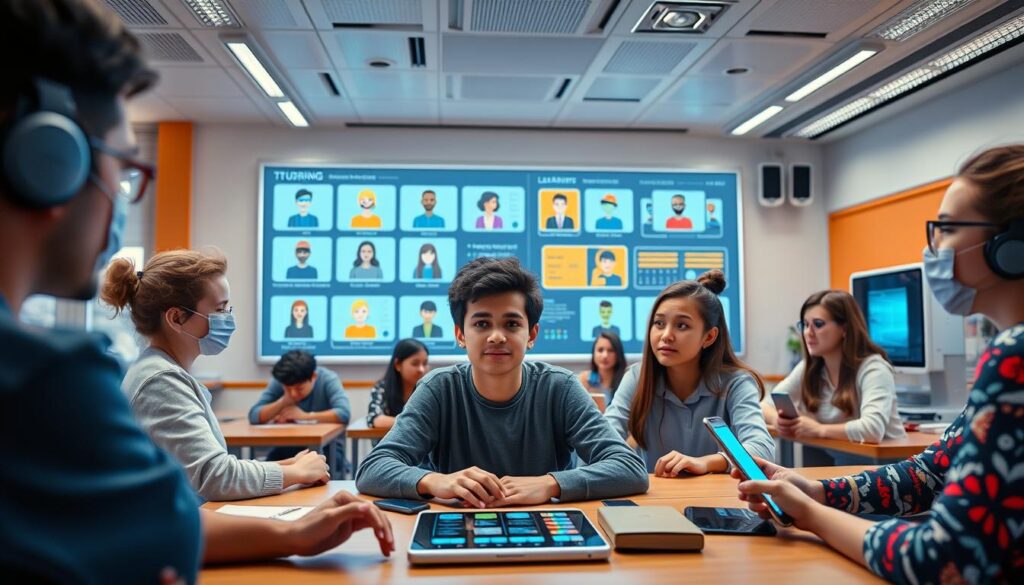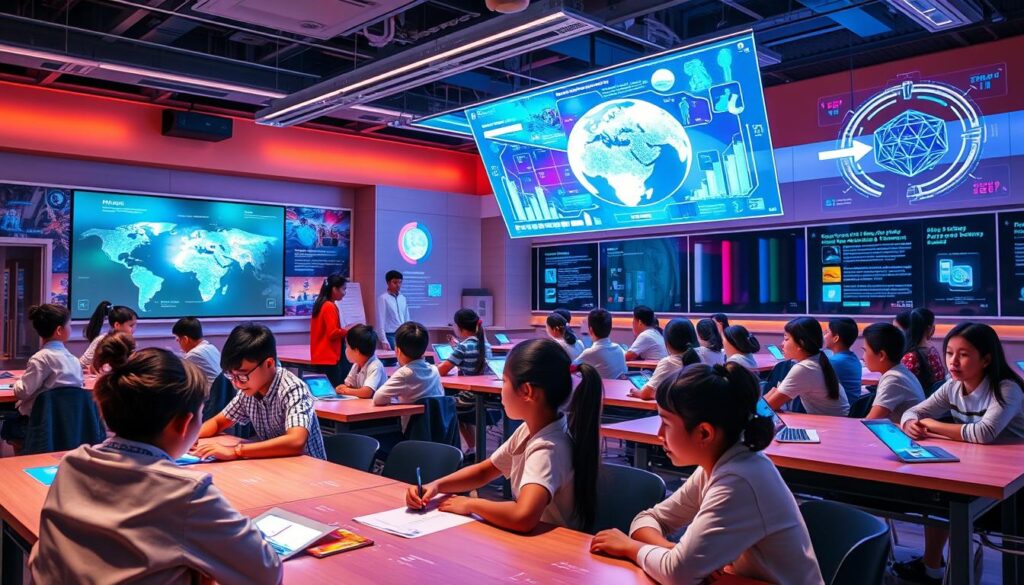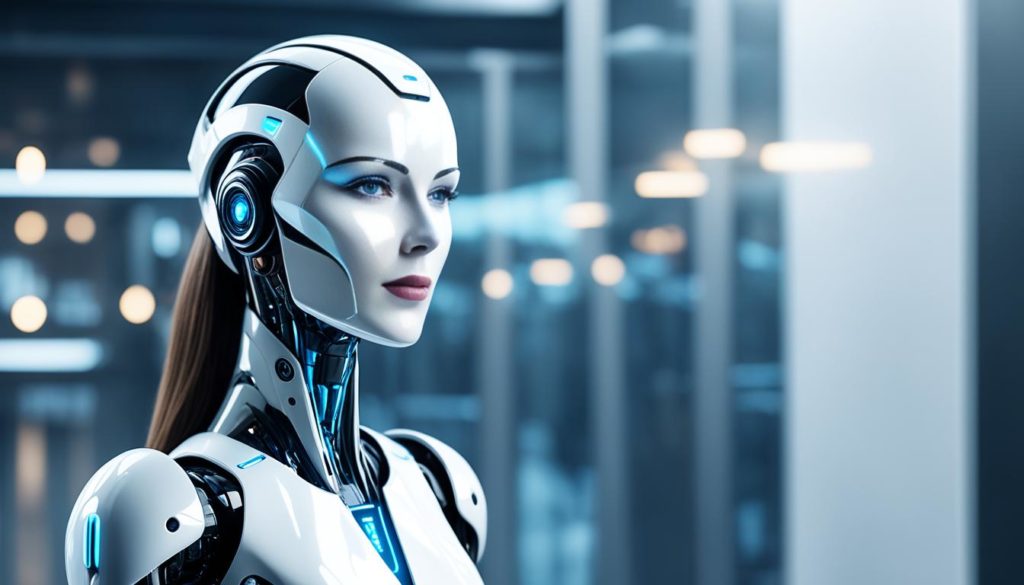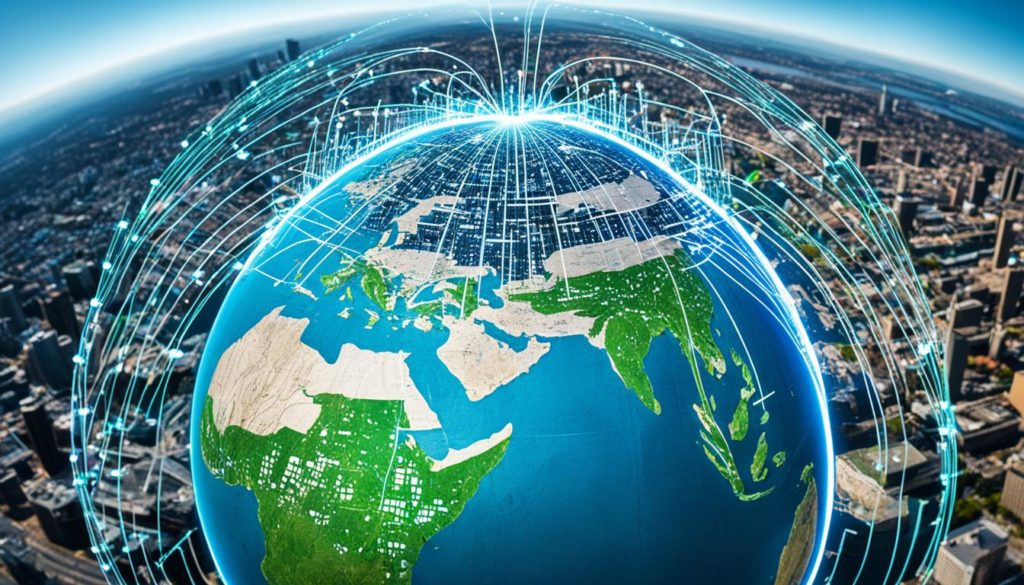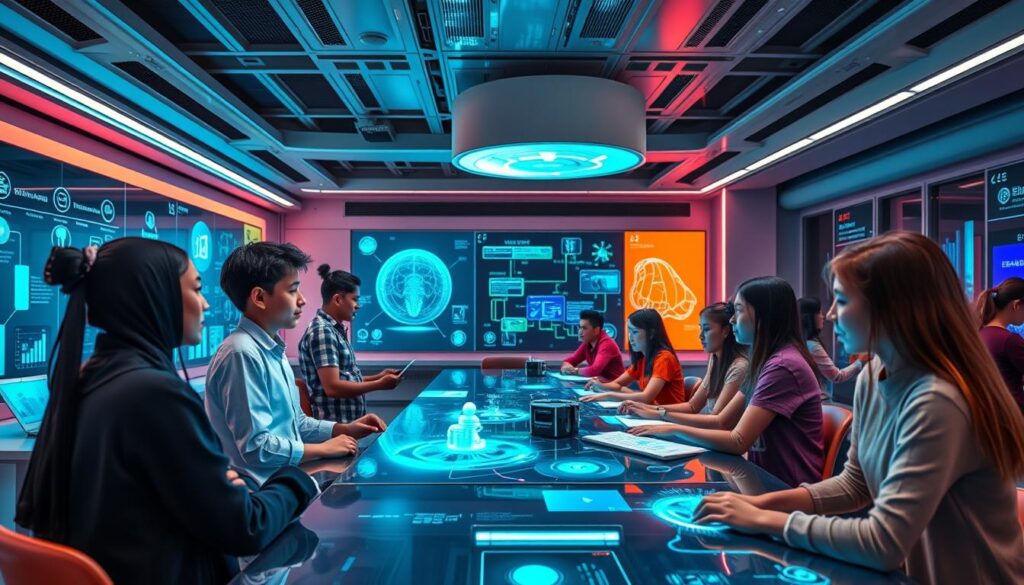
Did you know nearly 9,000 test participants were studied to see how generative AI affects education? It showed that those aged 18-29 struggle more to tell real news from fake than those 65 or older. This highlights the key role of AI in education in teaching us to be better at finding true information, making smarter learning essential today.
AI in education is changing how we teach and learn. It brings technology into the classroom, making learning more personal and freeing up teachers to focus on students’ growth.
AI helps us create learning plans that fit each student’s needs, letting them learn at their own speed. Tools like Gradescope for grading and Grammarly for checking grammar save teachers a lot of time, making their work more efficient and accurate.
Key Takeaways
- AI in education saves teachers a lot of time by automating grading and other tasks.
- AI makes learning personal by creating paths that fit each student’s needs.
- Tools like Grammarly and Gradescope boost learning efficiency and accuracy.
- AI tutoring systems offer 24/7 help in many subjects worldwide.
- Using AI in education leads to smarter learning and helps meet educational goals.
Introduction to AI in Education
Artificial intelligence is changing how we learn and teach. It combines new tech with old teaching methods. This mix brings new ways to meet different student needs.
As we look at how education tech has grown, it’s key to see how past and recent steps have shaped this field.
The Evolution of AI Technologies in Education
The start of AI in education was in the 1960s with the first tutoring systems. These early systems helped create today’s digital tools. These tools use machine learning to make learning personal.
AI also makes tasks like grading easier. This lets teachers focus more on helping students, making learning better.
Historical Milestones and Recent Advances
The first AI program was made in 1951, teaching a computer to play checkers. This sparked interest in AI. Alan Turing, in the 1930s, is seen as the father of AI and cognitive science.
Machine learning has grown a lot, letting computers learn from data on their own. This is a big part of AI.
Important moments in AI include better data analysis algorithms. These have made AI more useful in education and other areas. Today, AI is in many parts of our lives, like social media and facial recognition.
The U.S. National Science Foundation has backed AI projects. In 2019, guidelines for teaching AI in schools were set. This is a big step in using AI in learning.
AI is now helping students learn complex topics. For example, in Maine, AI helps students learn about birds. In Ukraine, AI games are teaching English. These examples show AI’s impact worldwide.
The growth of AI in education shows the need for ongoing improvement. We must address issues like bias and privacy. This evolution makes learning more engaging and effective.
| Year | Milestone | Impact |
|---|---|---|
| 1951 | First AI Program | Introduced AI through a checkers-playing computer program. |
| 1960s | Intelligent Tutoring Systems | Laid the groundwork for modern digital learning tools. |
| 2019 | NSF-Funded AI Guidelines | Established a framework for teaching AI in K-12 schools. |
| 2020s | Interactive AI Exhibits | Engaged young learners with accessible AI concepts. |
Personalized Learning Experiences
AI is changing how we learn. It uses adaptive technology and custom solutions to meet each student’s needs. This leads to better engagement and grades.
AI-Powered Tutoring Systems
AI-powered tutoring systems are a big part of this change. Tools like Carnegie Learning and Aleks use data to help students. They make learning more efficient and effective.
Teachers see a 70% boost in their work with AI. Students also see a 62% jump in their test scores. This shows how well AI tutoring works.
AI tutoring also helps teachers. It lets them focus on making learning fun. Teachers spend 50% less time on lesson plans, making learning more personal.
Custom Learning Pathways
AI helps create custom learning pathways for students. Tools like Knewton and DreamBox adjust lessons based on how students do. This lets students learn at their own speed.
AI also helps teachers predict and prevent problems. It’s 91% accurate in giving feedback. This helps students a lot.
AI is making learning better. Schools see a 40% rise in student success and a 60% increase in interest. The future looks bright for AI in education.
AI will soon power more learning systems. The global AI in education market is expected to grow fast. This shows how important AI is becoming in schools.
To learn more about AI in education, read this article.
Benefits of AI in Education
AI in education brings many benefits to students, teachers, and school leaders.
AI helps students learn better by tailoring lessons to their needs. It offers quick help on homework, reducing the need for teacher help. This makes learning more effective by focusing on areas where students need extra help.
AI also makes learning more accessible and fun. It can translate texts into different languages, making education more inclusive. This can boost student interest by up to 90%. These edtech solutions help create a welcoming learning space for everyone.
AI also makes school work more efficient. It handles routine tasks, freeing up teachers to teach more. This can cut down on administrative work by up to 80%. It makes the school day more productive and enjoyable for everyone.
AI helps make better decisions in schools by analyzing lots of data. It looks at how students do and how well teachers teach. This data helps shape better learning plans, ensuring decisions are based on solid facts.
Here’s a closer look at how AI helps in education:
| Aspect | Impact | Statistic |
|---|---|---|
| Personalized Learning Engagement | Increased student engagement | Up to 90% |
| Efficiency in Administrative Tasks | Reduction in time spent | Up to 80% |
| Equitable Learning Opportunities | Closing academic achievement gap | By 60% |
| Student Performance | Improved performance | By 75% |
| Technological Dependency | Increased dependency on AI | By 70% |
| Depersonalization | Potential depersonalization rate | Up to 50% |
| Memory Recall | Decrease in ability to recall facts | By 40% |
As AI grows, so does the future of education. We’re moving towards a world where learning is more personal, efficient, and informed. This will be key to success in schools.
AI in Education: Key Applications and Tools
AI applications and tools, like smart tutoring platforms, are key in today’s education. They offer real-time feedback and support to students, meeting different learning needs. Over 60% of teachers worldwide use AI classrooms to make their work easier.
AI helps with tasks like grading and organizing papers, freeing up teachers to teach and interact with students. Tools like ChatGPT 4 provide detailed insights to improve lessons and give feedback.
Smart Tutoring Platforms
Smart tutoring platforms are a big deal in education today. Platforms like Gurushala show AI’s growing role in digital learning. They offer learning experiences tailored to each student’s pace and understanding.
A survey by Forbes Advisor found that over half of teachers see AI as a positive change. AI platforms make learning fun with features like games. This makes students more engaged and interested in learning.
AI tools help teachers with tasks like grading and organizing papers. This lets teachers focus on teaching and interacting with students. Tools like ChatGPT 4 offer advanced features and accurate feedback.
While AI is not used by everyone, its use is growing. However, we must address concerns like bias and privacy as we use these tools more.
Challenges and Considerations
Using AI in education is not without its hurdles and ethical questions. It’s vital to tackle these issues head-on. This way, we can make the most of AI while keeping everyone’s interests safe.
Data Privacy and Security Concerns
AI in schools raises big data privacy in education worries. Schools deal with a lot of sensitive info. It’s key to have strong security to protect this data.
Keeping students’ personal info safe means using top-notch encryption and following data rules. If we fail, we risk identity theft and losing trust in AI.
Addressing Algorithmic Bias in AI Systems
Algorithmic bias is a big problem with AI in schools. AI can carry over biases from its training data, unfairly treating some students. For example, an AI test might favor certain students if it’s trained on biased data.
To fix this, developers need to make AI fair by using diverse training data. We also need to keep checking and fixing AI for bias. Being open about how AI makes decisions helps build trust in these tools.
Ensuring Equity and Accessibility
AI in schools must also focus on fairness. Some students face barriers like money, language, or location. Schools need to make AI tools affordable and accessible to all.
By doing things like offering AI in many languages and helping students who can’t afford it, we can make learning fairer. This way, AI can help everyone learn better.
Fixing these problems needs a mix of tech and ethics. We need clear rules, training for teachers, and making sure AI is available to all. This will help create a better AI-based learning system for everyone.
| Challenge | Impact | Solution |
|---|---|---|
| Data Privacy and Security Concerns | Potential breaches and loss of trust | Advanced encryption and compliance with data protection regulations |
| Algorithmic Bias | Unfair treatment of certain student groups | Diverse training data and continuous monitoring |
| Equity and Accessibility | Widening educational divide | Investing in accessible AI solutions and digital literacy programs |
Future Prospects and Innovation
The future of AI in education looks bright, with new AI innovations changing the game. Education 4.0 is set to shake things up, moving beyond old ways to make learning more dynamic and personal.
New trends like augmented reality, collaborative AI, and natural language processing are leading the charge. These advancements use AI to create learning spaces that are both engaging and tailored to each student. AI’s power to handle big data means learning can be more effective and personal.
A survey shows 44% of American teens might use AI for schoolwork, showing AI’s growing role. Bolton College in the UK cuts video creation time by 80% with AI, helping over 10,000 students. In Germany, the International University of Applied Sciences uses AI to reach over 100,000 students with 28,000 videos, showing AI’s vast potential in education.
AI also plays a big part in making education accessible. With AI, nearly 240 million kids with disabilities can learn better. By 2050, almost 9 billion people could enjoy Education 4.0 thanks to widespread internet access.
| Trend | Benefits | Statistics |
|---|---|---|
| Game-based Learning | Interactive and engaging educational experiences | Market expected to reach USD 29.7 billion by 2026 |
| AI-Enabled LMS | Enhanced student performance and personalized learning | Projected to dominate the market in the near future |
| Online Courses | Focused, collaborative, and direct interaction | Over 85% completion rates in smaller groups |
Looking ahead, AI’s role in education will be key for real-time, data-driven learning. With Education 4.0 and ongoing AI innovation, we’re in for a transformative future. For more on AI’s impact on education, check out this in-depth article on AI in education.
Conclusion
AI is changing education in big ways, making learning better for everyone. Tools like Khan Academy and Duolingo use AI to help students learn at their own pace. This means each student gets a learning experience that fits them best.
These tools are key to making education more effective. They help students understand complex subjects better. For example, Minecraft uses AI to make learning fun and interactive.
AI is making education more personal and engaging. Tools like ChatGPT offer one-on-one help to students. This is helping students learn more effectively.
But, we need to make sure everyone has access to these tools. We also need to teach people about AI. This will help fix the problem of unequal education.
Working together, we can make AI a positive force in education. This will lead to a brighter future for learning. To learn more about AI in education, visit Yellow Systems.
FAQ
How has AI evolved in the education sector over the years?
AI in education began with intelligent tutoring systems in the 1960s. Advances in machine learning and data analytics have sped up AI’s growth. Now, we see adaptive assessments, virtual tutoring, and automated tools.
What are the benefits of personalized learning in education?
Personalized learning uses AI to tailor education to each student’s needs. It makes learning more effective and helps teachers understand and support students better.
How do AI-powered tutoring systems work?
AI tutoring systems, like Carnegie Learning and Aleks, use data analytics to adjust content. They provide extra information and create learning paths based on each student’s performance.
What role does AI play in automating administrative tasks in education?
AI automates tasks like grading and managing student records. This makes education more efficient. It lets teachers focus on meaningful interactions with students.
What are the key applications of AI in education today?
Today, AI is used in smart tutoring platforms for real-time feedback and adaptive learning. It also helps with administrative tasks and data analytics for tracking student performance.
What are the primary challenges of integrating AI in education?
Challenges include ensuring data privacy and security. We must also address algorithmic biases and ensure equal access to AI technologies.
How can AI promote equity in education?
AI can offer personalized learning to all students, regardless of background. But, we must overcome barriers like socioeconomic, linguistic, and geographical ones to ensure everyone benefits.
What innovations are expected in the future of AI in education?
Future innovations include augmented reality, collaborative AI systems, and natural language processing. These will make learning more personalized and enhance the experience, aligning with Education 4.0 goals.
How can we ensure ethical integration of AI in education?
Ethical integration needs clear frameworks, educator training, and focus on equity. We must ensure data privacy, address biases, and promote fair access to AI tools.
Future App Studios is an award-winning software development & outsourcing company. Our team of experts is ready to craft the solution your company needs.


